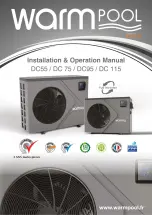
E-
10
Connecting the refrigerant pipe
There are two refrigerant pipes of different diameters:
A smaller one for the liquid refrigerant
A larger one for the gas refrigerant
The thickness of tube should not be less than 1.0mm.
The inside of copper tube must be clean & has no dust.
1
Remove the pinch pipe on the pipes and connect the assembly pipes
to each pipe, tightening the nuts, first manually and then with a torque
wrench, a spanner applying the following torque.
Outer Diameter
Torque (kgf•cm)
6.35 mm (1/4”)
9.52 mm (3/8”)
12.70 mm (1/2”)
15.88 mm (5/8”)
145~175
333~407
505~615
630~769
Note
If the pipes must be shortened refer to page 11.
2
Must use insulator which is thick enough to cover the refrigerant tube to
protect the condensate water on the outside of pipe falling onto the floor
and the efficiency of the unit will be better.
3
Cut off any excess foam insulation.
4
Be sure that there must be no crack or wave on the bended area.
5
It would be necessary to double the insulation thickness(10mm or more)
to prevent condensation even on the insulator when if the installed area is
warm and humid.
6
Do not use joints or extensions for the pipes that connect the indoor and
outdoor unit. The only permitted connections are those for which the units
are designed.
CAUTION
Use the bender which have a minimum
bending radius when you bend the pipe.
Be careful so that the pipes is bended one
time only. Piping will be very difficult if
you repeat the bending more than twice.
If you bend the pipe by using spring
Bending radius should be more than
100mm so that pipe is not distorted.
Spring pipe
Refrigerant oil
Torque wrench
Flare nut
Union
Spanner
CAUTION
Connect the indoor and outdoor units using pipes with flared co-
nnections(not supplied). For the lines, use insulated, unwelded, d-
egreased and deoxidized copper pipe,(Cu DHP type to ISO1337),
suitable for operating pressures of at least 4200kPa and for a burst
pressure of at least 20700kPa. Copper pipe for hydro-sanitary ap-
plications is completely unsuitable.
For sizing and limits (height difference, line length, max. bends,
refrigerant charge, etc.) see the outdoor unit installation manual.
All refrigerant connection must be accessible, in order to permit
either unit maintenance or removing it completely.







































